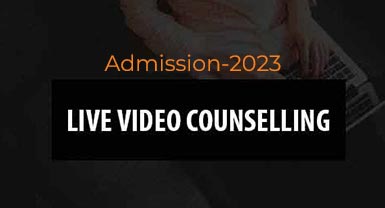Study Grant 1st Edition (Part II) Award Ceremony
1st Edition (Part II) of LPUNEST Study Grant Awards ceremony was held on 7th November 2020 at LPU. LPU awarded more than Rs. 4 Crore to students from across India to pursue Higher Education at Premier Institutes like IIT, NIT, IIM etc.
Conference Theme/Tracks
Contemporary Issues in Design
The perspectives and issues in Design have evolved with the passage of time as the constraints and enablers of art and design have changed. Need of the hour is to have a holistic understanding of issues relating to space, forms, frugality, sustainability and functionality etc. to enable creation of art and design, appropriate to the needs of the contemporary society.
- Optimizing space utilization Themes may include effective space designing, relation of design to its physical environment; relationship of design space to nature, function and activities etc.
- Contemporary trends in creative forms Themes may include experimental and novel forms and mediums/materials/techniques in design, design receptivity, contemporary popular design culture etc.
- Frugal design Themes may include design of products and services for social groups and societies with limited economic means; restricting functionality to design affordable products/services; dynamics of frugal design marketing etc.
- Sustainability in design Themes may include minimizing use of resources/ carbon footprint; recycling of materials; optimizing use of space; multi-functional designs of structures, spaces and products; strategies and policies to promote sustainability in design etc.
- Design functionality and aesthetics In the interest of fast execution of projects, the trend is to focus more on functionality, at the cost of aesthetics. Themes may include challenges, case studies and trends in synthesizing/balancing beauty of design and the functionality.
Interactivity in art and design
The focus while designing interfaces, products and facilities is on promoting interactivity, with the user for efficiency and obtaining meaningful feedback for continuous improvement.
- Effective and innovative interfaces Themes may include innovations in designing interfaces on the web, public places, points of sale and other points of contact/touch points between the agency offering the service and the users; role of interfaces in facilitating efficiency and feedback; scope of innovation in interface design etc.
- Accessibility and connectivity of design Themes may include use of design to promote accessibility of products/services/art and improving connectivity with and among the users; issues of maximizing reach of communication/messages through mass media etc.
- Design transformation from traditional to digital Themes may include evolution of design mediums and forms, new media in design; scope and scale of digitization; ethics of digital creations/manipulations; relationship of design and ethical values etc.
- Design dissemination Themes may include issues in propagation of design through social media and personal contact, current trends and perspectives etc.
- Visual Language of design Themes may include paradoxes in visual communication; effective design language; relationship between text and visual design
Education and Marketing Perspectives in Art and Design
Imagination, visualization and creativity are core to design skills and competencies. Kaleidoscopic efforts have been made to impart art and design education with varying results, calling for a review of the best practices. In the contemporary scenario, art has become an investment and design has become the core of innovation, making it imperative to systematically plan and market art and design.
- Design Education and Pedagogies Themes may include innovative practices for design teaching-learning; role and scope of technology, experiential learning and experimentation in design instruction; role of art and design appreciation and criticism; the dilemmas and challenges in design education etc.
- Synthesizing theory and practice of design Themes may include understanding, interpreting and incorporating perspectives of art and design practitioners and industry, in academics; scope of exploration and experimentation; challenges and opportunities of synthesizing etc.
- Design marketing Themes may include strategies for marketing of art and design output through traditional media and e-commerce; planning and marketing of innovation in art and design; contemporary perspectives of branding in art and design; design brands and their impact.




 Whatsapp
Whatsapp

